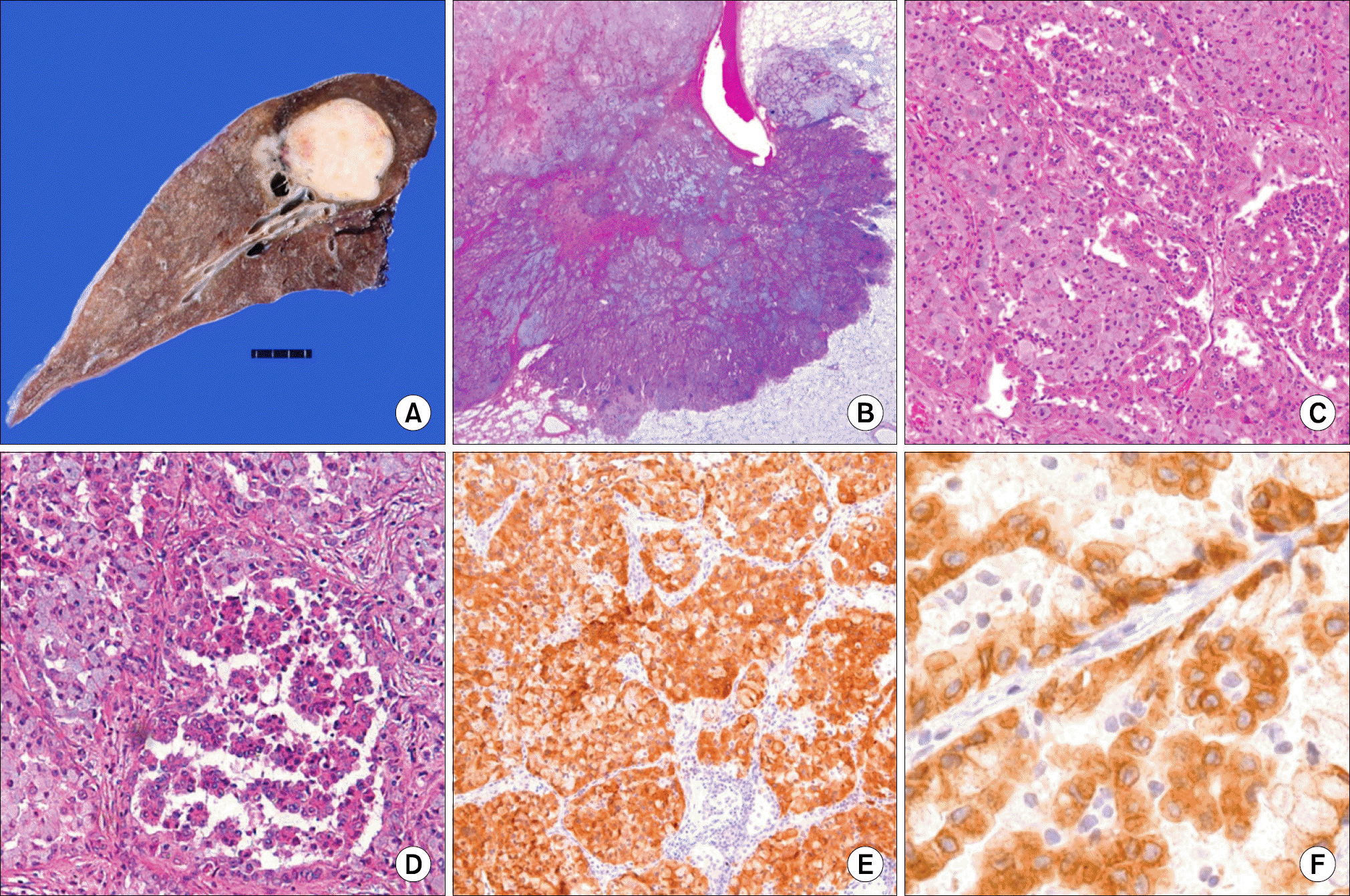Abstract
Purpose:
This study was designed to define the specific histologic features of anaplastic lymphoma kinase (ALK)-expressing pulmonary adenocarcinoma. Materials and Methods: Of the 580 pulmonary adenocarcinomas diagnosed between March 2010 and February 2011, immunohistochemical staining for ALK was performed in 269 cases showing any suspicious histologic features in previous reports. The subtype according to the World Health Organization classification and the characteristic histologic features were re-evaluated in ALK-expressing cases.
Results:
A total of 46 cases (7.9% of the 580 adenocarcinomas, 17.1% of the 269 studied cases) were positive for ALK. Among the 46 cases showing ALK positivity, 35 cases (76%) showed intra- and/or extracytoplasmic mucin. The most well-known characteristic finding asso-ciated with ALK, signet ring cells, was found in 18 cases (39.1%). Cribriform pattern with extracytoplasmic mucin was identified in five cases. In six cases, all three features were found. On the other hand, there were three other cases that did not show any of the aforementioned histologic features. In 12 lobectomy specimens, the most common histologic pattern was a solid pattern (five cases, 41.6%).
Conclusion: Intra- and/or extracytoplasmic mucin, including signet ring cell appearance and a cribriform pattern with extracytoplasmic mucin, are characteristic features of ALK-expressing non-small cell lung cancer.
Go to : 
REFERENCES
3. Mok TS, Wu YL, Thongprasert S, et al. Gefitinib or carboplatin-paclitaxel in pulmonary adenocarcinoma. N Engl J Med. 2009; 361:947–957.

4. Soda M, Choi YL, Enomoto M, et al. Identification of the transforming EML4-ALK fusion gene in non-small-cell lung cancer. Nature. 2007; 448:561–566.

5. Gerber DE, Minna JD. ALK inhibition for non-small cell lung cancer: from discovery to therapy in record time. Cancer Cell. 2010; 18:548–551.

6. Kwak EL, Bang YJ, Camidge DR, et al. Anaplastic lymphoma kinase inhibition in non-small-cell lung cancer. N Engl J Med. 2010; 363:1693–1703.

7. Cagle PT, Dacic S. Lung cancer and the future of pathology. Arch Pathol Lab Med. 2011; 135:293–295.

8. Yi ES, Boland JM, Maleszewski JJ, et al. Correlation of IHC and FISH for ALK gene rearrangement in non-small cell lung carcinoma: IHC score algorithm for FISH. J Thorac Oncol. 2011; 6:459–465.

9. Takeuchi K, Choi YL, Togashi Y, et al. KIF5B-ALK, a novel fusion oncokinase identified by an immunohistochemis-try-based diagnostic system for ALK-positive lung cancer. Clin Cancer Res. 2009; 15:3143–3419.

10. Takahashi T, Sonobe M, Kobayashi M, et al. Clinicopathologic features of non-small-cell lung cancer with EML4-ALK fusion gene. Ann Surg Oncol. 2010; 17:889–897.

11. Inamura K, Takeuchi K, Togashi Y, et al. EML4-ALK lung cancers are characterized by rare other mutations, a TTF-1 cell lineage, an acinar histology, and young onset. Mod Pathol. 2009; 22:508–515.

12. Yoshida A, Tsuta K, Watanabe S, et al. Frequent ALK rearrangement and TTF-1/p63 co-expression in lung adenocarcinoma with signet-ring cell component. Lung Cancer. 2011; 72:309–315.

13. Jokoji R, Yamasaki T, Minami S, et al. Combination of morphological feature analysis and immunohistochemistry is useful for screening of EML4-ALK-positive lung adenocarcinoma. J Clin Pathol. 2010; 63:1066–1070.

14. Travis WD, Brambilla E, Noguchi M, et al. International association for the study of lung cancer/american thoracic society/european respiratory society international multidisci-plinary classification of lung adenocarcinoma. J Thorac Oncol. 2011; 6:244–285.
15. Travis WD, Brambilla E, Noguchi M, et al. International association for the study of lung cancer/american thoracic society/european respiratory society international multidisci-plinary classification of lung adenocarcinoma. J Thorac Oncol. 2011; 6:244–285.
16. Sasaki T, Rodig SJ, Chirieac LR, Jä nne PA. The biology and treatment of EML4-ALK non-small cell lung cancer. Eur J Cancer. 2010; 46:1773–1780.

17. Rodig SJ, Mino-Kenudson M, Dacic S, et al. Unique clinicopathologic features characterize ALK-rearranged lung adenocarcinoma in the western population. Clin Cancer Res. 2009; 15:5216–5223.

18. Mino-Kenudson M, Chirieac LR, Law K, et al. A novel, highly sensitive antibody allows for the routine detection of ALK-rearranged lung adenocarcinomas by standard immunohistochemistry. Clin Cancer Res. 2010; 16:1561–1571.

19. Boland JM, Erdogan S, Vasmatzis G, et al. Anaplastic lymphoma kinase immunoreactivity correlates with ALK gene rearrangement and transcriptional up-regulation in non-small cell lung carcinomas. Hum Pathol. 2009; 40:1152–1158.

Go to : 
 | Fig. 1.Representative example of ALK-expressing pulmonary adenocarcinoma. (A) The cut surface in the lobectomy specimen shows a well-demarcated pale yellow solid mass. (B∼ D) The specimen is consisted of mixed histologic patterns including solid, acinar, and papillary pattern. Intra- and/or extracytoplasmic mucin with signet ring cells were frequently identified (hematoxylin-eosin stain, ×16, ×100, and ×200 respectively). (E, F) ALK antibody stains cytoplasm of tumor cells diffusely with slightly granular pattern (ABC method, ×100 and ×400 respectively). |
Table 1.
Characteristics of Patients and Specimens
| Age (median), yr | 25∼77 (52) | |
|---|---|---|
| Sex | Male | 20 (43.5) |
| Female | 26 (56.5) | |
| Procedure | Lung biopsy | 22 (47.8) |
| Lobectomy | 12 (26.1) | |
| LN biopsy | 10 (21.7) | |
| Wedge resection | 1 (2.2) | |
| Metastasectomy | 1 (2.2) |
Table 2.
Pathologic Features in Immunohistochemically ALK- positive NSCLC




 PDF
PDF ePub
ePub Citation
Citation Print
Print


 XML Download
XML Download